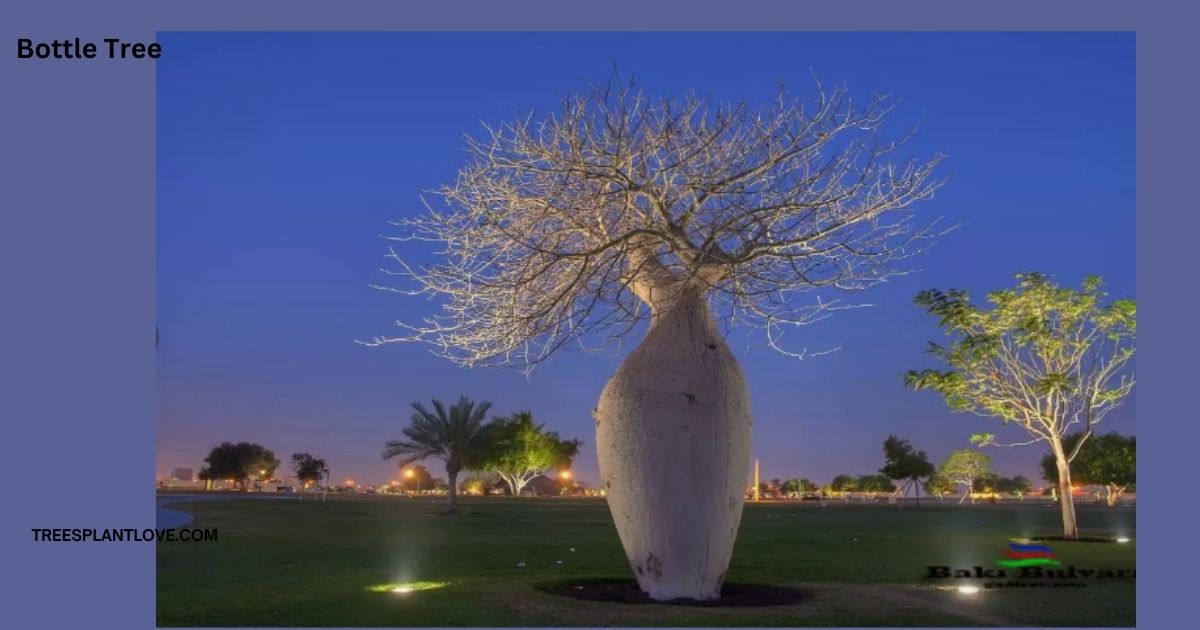
Bottle Tree: Discover Its Symbolism, Beauty, and How to Grow One in Your Garden
Bottle Tree: The bottle tree, a unique and eye-catching plant, has captured the imagination of many gardeners and nature enthusiasts around the world. Known for its striking appearance, where its branches are adorned with glass bottles, this tree is more than just an ornamental feature.
Its cultural significance, stunning aesthetic, and practical benefits make the bottle tree a fascinating subject of discussion. In this article, we will explore the history, symbolism, and care of bottle trees, along with tips on how to create your own.
What is a Bottle Tree?
A bottle tree is typically a tree or shrub adorned with bottles—often colorful glass ones—hanging from its branches. These trees are most commonly seen in the southern United States, especially in African-American communities, but they also have roots in various cultures around the world. While the bottle tree itself may seem unusual, the practice of decorating trees with bottles has a deeper significance.
The “bottle tree” name is typically associated with two different types of trees: one, a literal tree used to hang bottles, and another, a plant species known as the Brachychiton populneus, or Australian Bottle Tree. While both are interesting in their own right, for the purposes of this article, we’ll delve into the tradition of bottle trees in both contexts.
The Cultural Significance of Bottle Trees
Bottle trees are not merely decorative; they have deep cultural roots, particularly in African-American history. The tradition of hanging bottles on trees originated in Africa and was brought to the southern United States by enslaved Africans. In African folklore, it was believed that bottles, particularly those with blue or green glass, could trap evil spirits or “jinxes.” The bottles would lure the spirits into the tree, where they would be trapped and unable to cause harm to the living.
This practice was passed down through generations, and it eventually became an iconic feature of Southern folk culture, especially in rural areas. Many bottle trees can be found in front yards of homes, often alongside the path to the front door, serving as both a spiritual protector and a decorative element.
In addition to their spiritual significance, bottle trees are seen as symbols of resilience. They represent the ability to take something seemingly ordinary—like a bottle—and transform it into something meaningful and beautiful. Over time, this tradition of bottle trees has spread beyond the Southern United States and has been embraced in gardens and homes worldwide.
The Australian Bottle Tree: A Different Kind of Bottle Tree
While the “bottle tree” most often refers to the tradition of hanging bottles on trees, it can also refer to a unique species of tree from Australia known as Brachychiton populneus. This tree, also called the Australian Bottle Tree, has a distinct appearance, with its bulbous trunk that resembles a bottle shape. Native to the dry regions of Australia, the bottle tree is well-adapted to arid climates and is known for its water-storing capacity in its swollen trunk, much like other desert plants.
This species is prized for its striking silhouette and drought-tolerant nature. The tree’s greenleaves are often arranged in clusters at the tips of its branches, giving it a sparse, otherworldly look. In bloom, the Australian bottle tree produces clusters of large, red or yellow flowers, adding a vibrant contrast to its otherwise understated foliage.
Though not directly related to the tradition of hanging bottles, the Australian bottle tree is another example of a “bottle” tree that has captured the attention of gardeners and plant lovers for its unique beauty and low-maintenance care.
How to Create Your Own Bottle Tree
Whether you want to create a traditional bottle tree or cultivate an Australian bottle tree in your garden, both types offer distinct aesthetic and symbolic benefits. Here’s how you can grow and care for each type:
Traditional Bottle Tree (Bottle Decoration Tradition)
- Choose a Tree: Pick a tree with sturdy branches that can support the weight of glass bottles. Many people use trees like crepe myrtles, magnolias, or even ornamental trees such as the dogwood or holly.
- Select Your Bottles: Choose a variety of bottles, including colored glass bottles like blue or green, as they are believed to attract and trap spirits. Vintage bottles, such as old soda or beer bottles, add charm to the display.
- Prepare the Tree: Securely attach the bottles to the branches using sturdy twine, wire, or string. Make sure that the bottles are safely secured, as the weight of the glass could potentially cause the branches to snap.
- Display: Once the bottles are in place, your bottle tree will serve as both a piece of art and a symbolic protector of your home. Place it in a sunny area to allow the sunlight to make the bottles sparkle.
Australian Bottle Tree (Brachychiton populneus)
- Planting: Choose a location with full sun and well-drained soil. The Australian bottle tree prefers hot, dry conditions and can tolerate drought once established.
- Watering: Water the tree thoroughly when first planted. After that, allow the soil to dry out between waterings, as the tree is drought-tolerant and does not need frequent watering.
- Fertilizing: Fertilize the tree in the spring with a balanced fertilizer to encourage healthy growth. Avoid over-fertilizing, as this can lead to excessive foliage and reduced flower production.
- Pruning: While the Australian bottle tree requires minimal pruning, you can remove dead or damaged branches to maintain its shape. This tree generally requires little intervention, making it a perfect choice for low-maintenance gardeners.
Benefits of Having a Bottle Tree
- Aesthetic Appeal: The bottle tree adds a unique and colorful touch to your garden or yard, whether through hanging bottles or the sculptural beauty of the Australian bottle tree.
- Symbolic Protection: For those who appreciate the historical and cultural significance of bottle trees, they offer a sense of spiritual protection, guarding the home from negative energy and ill fortune.
- Water Conservation: If you opt for the Australian bottle tree, you’ll enjoy the benefit of a drought-tolerant plant that requires minimal water, making it an excellent choice for dry regions or those looking to conserve water in their garden.
- Conversation Starter: The unique nature of the bottle tree, especially when decorated with colorful bottles, makes it an interesting topic of conversation for visitors and passersby.
Conclusion
The bottle treeis a fascinating and multifaceted plant, both in terms of its cultural significance and its visual appeal. Whether you embrace the tradition of hanging bottles to ward off evil spirits or admire the striking form of the Australian bottle tree, incorporating a bottle tree into your garden or landscape is a beautiful way to add character, symbolism, and resilience to your outdoor space. The bottle tree, in all its forms, is a testament to the human desire to find beauty and meaning in the world around us, making it a truly unique addition to any home or garden.

Leave a Reply